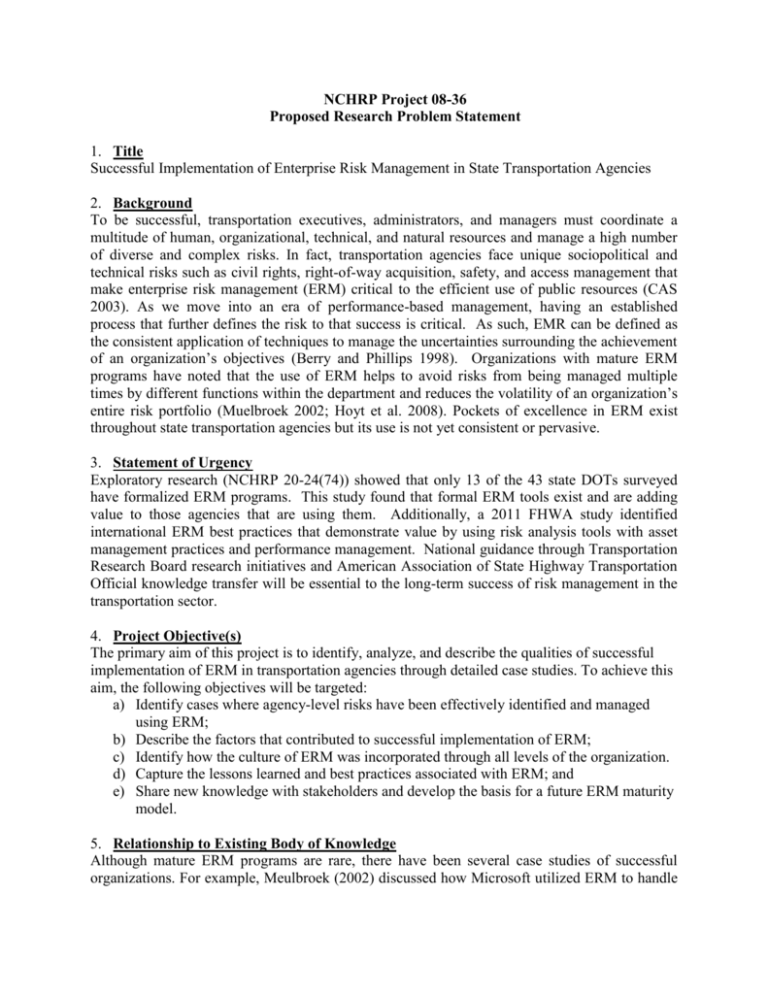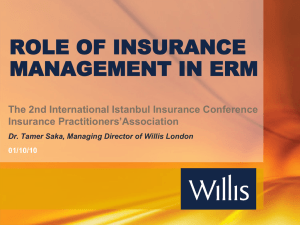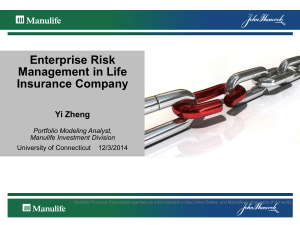ERM Problem Statement 27MAR12
advertisement

NCHRP Project 08-36 Proposed Research Problem Statement 1. Title Successful Implementation of Enterprise Risk Management in State Transportation Agencies 2. Background To be successful, transportation executives, administrators, and managers must coordinate a multitude of human, organizational, technical, and natural resources and manage a high number of diverse and complex risks. In fact, transportation agencies face unique sociopolitical and technical risks such as civil rights, right-of-way acquisition, safety, and access management that make enterprise risk management (ERM) critical to the efficient use of public resources (CAS 2003). As we move into an era of performance-based management, having an established process that further defines the risk to that success is critical. As such, EMR can be defined as the consistent application of techniques to manage the uncertainties surrounding the achievement of an organization’s objectives (Berry and Phillips 1998). Organizations with mature ERM programs have noted that the use of ERM helps to avoid risks from being managed multiple times by different functions within the department and reduces the volatility of an organization’s entire risk portfolio (Muelbroek 2002; Hoyt et al. 2008). Pockets of excellence in ERM exist throughout state transportation agencies but its use is not yet consistent or pervasive. 3. Statement of Urgency Exploratory research (NCHRP 20-24(74)) showed that only 13 of the 43 state DOTs surveyed have formalized ERM programs. This study found that formal ERM tools exist and are adding value to those agencies that are using them. Additionally, a 2011 FHWA study identified international ERM best practices that demonstrate value by using risk analysis tools with asset management practices and performance management. National guidance through Transportation Research Board research initiatives and American Association of State Highway Transportation Official knowledge transfer will be essential to the long-term success of risk management in the transportation sector. 4. Project Objective(s) The primary aim of this project is to identify, analyze, and describe the qualities of successful implementation of ERM in transportation agencies through detailed case studies. To achieve this aim, the following objectives will be targeted: a) Identify cases where agency-level risks have been effectively identified and managed using ERM; b) Describe the factors that contributed to successful implementation of ERM; c) Identify how the culture of ERM was incorporated through all levels of the organization. d) Capture the lessons learned and best practices associated with ERM; and e) Share new knowledge with stakeholders and develop the basis for a future ERM maturity model. 5. Relationship to Existing Body of Knowledge Although mature ERM programs are rare, there have been several case studies of successful organizations. For example, Meulbroek (2002) discussed how Microsoft utilized ERM to handle sudden market fluctuations and decrease operating costs and Gates (2006) described how Terasen, a Canadian energy company, uses ERM to reduce revenue volatility, effectively use available capital, and evaluate human resource risk. These studies showed that strong, unified support from senior management is critical to successful implementation of an ERM and that a major barrier to ERM implementation is the inability of analysts to adequately identify and accurately quantify risks. To enhance potential for success, the Committee of Sponsoring Organizations (COSO) suggests a top-down risk management approach that prevents the organization from being exposed to a single systemic risk and risk management policies that help shift employees’ mindsets from a unit or project-level risk management approach to an organization-wide strategy that allows for risk syndication. Despite the growing body of knowledge in the private sector, there is only one study of ERM in the public transportation sector (NCHRP 20-24(74)). As previously mentioned, this exploratory study focused on benchmarking implementation, identifying key characteristics of mature organizations, and evaluating the role that ERM plays in the achievement of transportation agency objectives. The present study would build directly upon this body of knowledge and would make important advancements by identifying the specific strategies that have been successfully employed by the transportation agencies with the most mature ERM programs to manage high priority risks. These success stories can be used to inspire confidence in agencies with less mature ERM programs and to increase their initial probability of success. 6. List of Anticipated Work Tasks To achieve the aforementioned research objectives the following specific tasks will be performed: Task 1 - Conduct interviews with representatives from state transportation agencies that are known to have the most mature ERM programs (identified in NCHRP 20-24(74)) to identify cases of successful use of ERM strategies to manage high-level agency risks (e.g., project selection, safety, material price escalation, fleet management). Task 2 - Perform detailed case studies of the 4 to 6 most successful ERM cases. The unit of analysis will be the agency-level risk that was managed to identify the: traditional method of risk management that were formerly implemented; supportive agency management strategies; organizational processes and structural elements that facilitated successful transition; roles and responsibilities of key personnel; lessons learned and strategies for continuous improvement; and other elements that contributed to success. Task 3 - Analyze case study results to match patterns across successful cases. The patterns will then be used to form recommendations, which will be reviewed by an expert panel comprised of executive representatives of agencies with mature ERM programs. Task 4 - Write a white paper for each case study and a summary report that focuses on the successful implementation of ERM in state DOTs and other transportation agencies that focuses on the lessons learned in successful cases. 7. Estimate of Funds Needed $100,000 8. Estimate of Time Needed to Complete the Research 9. Name, Affiliation and Contact Information of Submitter(s) 12 months Mike Hancock, Secretary of the Kentucky Transportation Cabinet and Chair of the AASHTO Standing Committee on Planning Office of the Secretary Kentucky Transportation Cabinet 200 Mero Street Frankfort, KY 40622 Phone: 502-564-5102 Tim Henkel, Assistant Commissioner Minnesota Department of Transportation and Vice Chair of the AASHTO Standing Committee on Planning 395 John Ireland Boulevard Mail Stop 120 St. Paul, MN 55155-1899 651-366-4829 10. Date of Submittal March 31, 2012 11. References Berry, A. and Phillips, J. (1998). “Enterprise Risk Management: Pulling it Together.” Risk Management, 45(9): 53-58. (CAS) Enterprise Risk Management Committee. (2003). “Overview of Enterprise Risk Management.” Causality Actuarial Society. Gates, S. (2006). “Incorporating Strategic Risk into Enterprise Risk Management: A Survey of Current Corporate Practice.” Journal of Applied Corporate Finance, 18(4): 81-90. Hoyt, R.E., Moore, D.L., and Liebenberg, A.P. (2008). “The Value of Enterprise Risk Management: Evidence from the U.S. Insurance Industry.” Society of Actuaries, Schaumberg, Illinois. Meulbroek, L.K. (2002). “A Senior Manager’s Guide to Integrated Risk Management.” Journal of Applied Corporate Finance, 14(4): 56-70. National Cooperative Research Program (2011). “Executive Strategies for Risk Management by State Departments of Transportation,” NCHRP Project 20‐24(74), National Cooperative Research Program, Transportation Research Board of the National Academies, Washington, DC, 2011.









